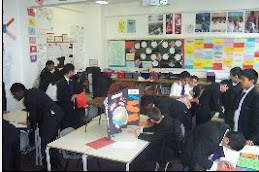 That said, when I'm dealing with the collection of 30 papers, listening to excuses is tiring. Particularly if they are of the "I lost my memory stick" variety. I therefore insist that every student hands in a piece of paper -- if they don't have homework, they turn in a Homework Excuse Note. The format of this note was stolen from somewhere many years ago and adapted to my classroom needs (I can't remember where so if anyone recognises please let me know!).
That said, when I'm dealing with the collection of 30 papers, listening to excuses is tiring. Particularly if they are of the "I lost my memory stick" variety. I therefore insist that every student hands in a piece of paper -- if they don't have homework, they turn in a Homework Excuse Note. The format of this note was stolen from somewhere many years ago and adapted to my classroom needs (I can't remember where so if anyone recognises please let me know!). The note works for 2 reasons. One, it is discrete, meaning that students with real problems write without having others over-hear and it doesn't make for a din in the class when 10 students try to explain why their work is missing. Secondly, it is on paper as physical evidence of the excuse. Students are reluctant to commit lies to paper, particularly as they know I check stories (wherever possible) during my homework-marking sessions. If they lie, I have proof. I also keep all the notes in my class records so I can discuss them with parents if required. The dread of this means that almost all students get their homework in on time - mission accomplished!
Update - I found the website I stole this from, it's http://www.teachertools.org/forms_dynam.asp. A brilliant site with hundreds of free templates of forms that teachers might use - e.g. hall passes, homework passes, etc.

















